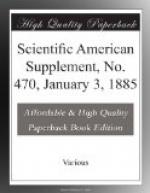them, and they will be mixed and confounded.
They will no longer be distinguishable by their heat
of constitution. It is true that, in passing into
the state of a vapor, a liquid absorbs a great deal
of latent heat, but that is employed in scattering
the molecules and keeping them at a distance; and
there will be none of it if the distance does not increase.
We are then, at this stage of our experiments, in
the presence of a critical point, at which we do not
know whether the matter is liquid or gaseous; for,
in either condition, it has the same density, the
same heat of constitution, and the same properties.
It is a new state, the gaso-liquid state. An
experiment of Cagniard-Latour re-enforced this explanation
of the phenomena. Heating ether in closed vessels
to high temperatures, he brought it to a point where
the liquid could be made wholly to disappear, or to
be suddenly reformed on the slightest elevation or
the slightest depression of temperature accordingly
as it was raised just above or cooled to just below
the critical point. The discovery of these properties
suggested an explanation of the failure of previous
attempts to liquefy air. Air at ordinary low
temperatures is in the gaso-liquid condition, and
its liquefaction is not possible except when a difference
exists between the density of the vapor and that of
the liquid greater than it is possible to produce
under any conditions that can exist then. It was
necessary to reduce the temperature to below the critical
point; and it was by adopting this course that MM.
Cailletet and Raoul Pictet achieved their success.
The rapid escape of the compressed gas itself from
a condition of great condensation at an extremely
low temperature was employed as the agent for producing
a greater degree of cold than it had been possible
before to obtain. M. Cailletet used oxygen escaping
at -29 deg. C. from a pressure of three hundred
atmospheres; M. Raoul Pictet, the same gas escaping
at -140 deg. from a pressure of three hundred and twenty
atmospheres; and both obtained oxygen and nitrogen,
and M. Pictet hydrogen, in what they thought was a
liquid, and possibly even in a solid form.
Still, it could not be asserted that hydrogen and
the elements of the air had been completely liquefied.
These gases had not yet been seen collected in the
static condition at the bottom of a tube and separated
from their vapors by the clearly defined concave surface
which is called a meniscus. The experiments
had, however, proved that liquefaction is possible
at a temperature of below -120 deg. C. (-184 deg.
Fahr.). To make the process practicable, it was
only necessary to find sufficiently powerful refrigerants;
and these were looked for among gases that had proved
more refractory than carbonic acid and protoxide of
nitrogen. M. Cailletet selected ethylene, a hydrocarbon
of the same composition as illuminating gas, which,
when liquefied by the aid of carbonic acid and a pressure
of thirty-six atmospheres, boils at -103 deg.




